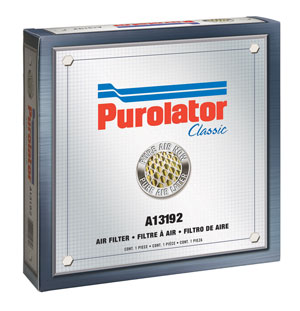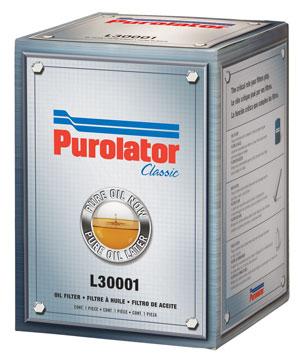Purolator, the inventor of the oil filter in 1923, has announced that its standard line of Purolator oil and air filters will now be marketed as Purolator Classic. This branding will be added to packaging, sales and marketing brochures, website and other Purolator promotional materials. The announcement was made by Ramon Nuñez, director of filtration for Bosch, joint venture owner of Purolator Filters NA LLC.

Originally referred to as Purolator PremiumPlus and subsequently just Purolator, the shift to ‘Classic’ is a natural outcome of the company’s heritage as the inventor of the industry’s first automotive oil filter, Nuñez said.
Purolator Classic oil and air filters will be backed by the same sophisticated engineering that has allowed them to provide excellent filtration, reliability, and value over the years. Purolator’s PureONE premium oil and air filters will continue to provide the ultimate in performance to motorists and service professionals who want a top-of-the-line filter.
"Consumers and technicians alike know that, since Purolator invented the very first automotive oil filter in 1923, our oil filters and, subsequently our air filters, have become the yardstick by which all filters are measured," said Nuñez. "Our filters are literally perceived as ‘classics’ by professionals and DIYers who appreciate their reliability and respect the technology that backs their performance."

"Furthermore, the Purolator Classic oil and air filter packaging design now communicates the same powerful brand message of quality consistent with our premium PureONE oil and air filters, and reflects the advanced technology found in every Purolator filter," said Nuñez.
The Purolator Classic oil filter’s multi-fiber high-density media provides a vehicle’s engine with excellent protection against harmful contaminants at a slightly lower price than the PureONE. Whether one is driving on the highway or around town, the Purolator Classic oil filter is 97.5 percent efficient, featuring an internally lubricated Nitrile gasket that requires less torque for filter removal, as well as an anti-drainback valve where applicable that protects against engine dry start.
The Purolator Classic air filter features a multi-fiber high-density media that is engineered and tested to trap 96.5 percent of harmful contaminants (based on ISO 5011 on A13192) before they can enter and damage a car’s engine. According to Nuñez, "A dirty or clogged air filter reduces engine power, decreases throttle response and increases engine wear. A fresh, clean Purolator Classic air filter not only helps improve vehicle performance and gas mileage, but also prevents costly repairs down the road." For best results, Nuñez advises changing a vehicle’s air filter every 12 months or 12,000 miles.
Purolator manufactures and supplies high quality automotive filters to the North American aftermarket. Inventor of the automotive oil filter in 1923, Purolator has, since then, pioneered more than 40 ‘firsts’ in the filtration industry. In fact, the first automotive oil filter was called a ‘Purolator,’ short for ‘pure oil later.’ Currently, the Purolator brand has more than 2,000 part numbers for automotive, light truck and heavy-duty applications. Now part of the Bosch umbrella of automotive aftermarket products within NAFTA, Purolator’s advanced aftermarket filters include:
• PureONE and Purolator Classic oil filters
• PureONE and Purolator Classic air filters
• BreatheEASY cabin air filters
• The ‘forgotten filters,’ including transmission filters, fuel filters, breathers and PCV valves.
To learn more about Purolator filters and the filtration category, visit www.purolatorautofilters.net.













